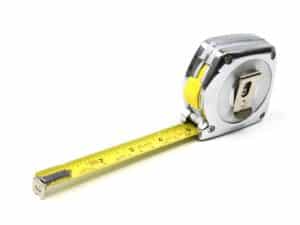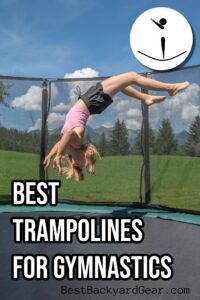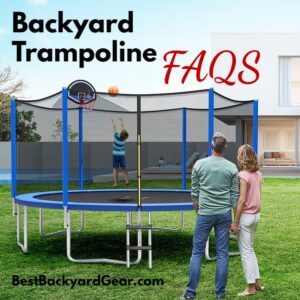 Are you considering buying a trampoline for your backyard, but feeling overwhelmed by all the options and safety concerns? Look no further! In this article, we’ll answer all your burning questions about backyard trampolines and provide you with the information you need to make the best decision for your family.
Are you considering buying a trampoline for your backyard, but feeling overwhelmed by all the options and safety concerns? Look no further! In this article, we’ll answer all your burning questions about backyard trampolines and provide you with the information you need to make the best decision for your family.
Whether you’re wondering about placement, safety features, or accessories, we’ve got you covered. So, let’s dive in and explore everything you need to know about backyard trampolines!
Here are 22 of the most popular trampoline FAQs asked and answered for you.
Backyard Trampoline FAQs
Trampoline Placement and Installation
- Where should you place a trampoline?
- How much space do you need around your trampoline?
- Can you dig a pit under your trampoline and bury it in the ground?
- Are In Net or Out Net Trampolines Better? (Link to full article)
- Can You Store Your Trampoline Upside Down? (Link to full article)
- Do You Have To Break In A New Trampoline? (Link to full article)
Trampoline Safety
- Are trampolines good for toddlers?
- How many kids can jump on a trampoline at the same time?
- What is dangerous for kids to do on a trampoline?
- Who invented the trampoline safety net?
- How often should you replace the safety net?
- Can you remove the safety net altogether?
- What is a Springfree trampoline?
- Does Home Owners Insurance cover trampolines?
Trampoline Maintenance and Cleaning
- How are trampolines measured?
- How long do backyard trampolines last?
- What Is Making My Trampoline Warp? (Link to full article)
- Why Are Trampolines Bouncier When They Are Wet? (Link to full article)
- How Do You Get Trampoline Stains Out Of Clothes? (Link to full article)
- How Do You Get Bird Poop Off A Trampoline? (Link to full article)
Trampoline Accessories
Trampoline and Athletic Performance
- Can Jumping On A Trampoline Increase Your Vertical Jump? (Link to full article)
- Are There Health Benefits From Jumping On A Trampoline? (Link to full article)
Where Should You Place A Trampoline?
Any surface is ok, provided it is level and able to be secured down (anchored or weighted with sandbags). So yes, a concrete driveway is fine. So is a grassy backyard, an artificial turf lot, and anything else that fits those 2 requirements.
Aside from surface type, you need to also make sure that the trampoline has a safety zone around it (6′ minimum). This means you can not, for example, place the trampoline right up against a garage wall or fence, or place it under a tree where there’s any chance of hitting branches or the tree trunk.
Underneath the trampoline should also be free and clear (ie, no boulders or old tree stumps jutting out of the ground).
How are trampolines measured?
Trampolines are measured from the outside edge of the whole trampoline. So a 14′ trampoline would likely have a jumping mat that is 11″ in diameter (assuming an 18″ mat covering the springs on both sides).
How much space do you need around your trampoline?
The recommended safety zone size is 6 feet all the way around the trampoline. So, if your trampoline is a 14′ round, you’ll need a diameter of 26′ ideally (6′ + 14′ + 6′).
Can you dig a pit under your trampoline and bury it in the ground?
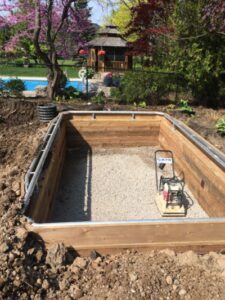
Yes, this is totally doable, but you’ll need to do some extra prep to make sure your trampoline doesn’t rust underground (due to constant dampness), or sink into the ground too far.
“Buried” trampolines are referred to as Inground Trampolines. You can actually buy special kits for installing them, or you can do it yourself and adapt an “above ground” trampoline.
You’ll want to have a retaining wall dug and secured that is the same shape and size as the trampoline to start, consider drainage underneath, and make sure the legs on the trampoline are secured properly. You’ll also need to consider keeping the trampoline mat slightly elevated to allow for air movement.
You still need to have a safety enclosure around inground trampolines, as aggressive jumpers can jump high enough that a surprise redirection and landing on hard ground can cause serious, jarring injury.
Are trampolines good for toddlers?
Trampolines can be very dangerous places for toddlers, especially if they are on it with another person. As toddlers aren’t steady on their OWN feet yet, any unpredictable movement in the mat will cause a smaller child to loose his or her balance and have a fall that can be quite painful.
Children just figuring out balancing and walking will find being “double bounced” a scary feeling.
From my own experience as a parent, however, if the toddler is on the trampoline completely by himself/herself, however, he/she will likely fully enjoy the sensation of walking on the mat! And if you get on it yourself and lightly bounce with your toddler safely in your arms, Dads and Moms, you’ll get some serious giggles. But keep in mind the danger of double-bouncing them.
Remember, kids under approx 10 years old still have bones that are relatively soft, so fractures from bad landings or children bumping into each other are much more likely for small children!
Also: If you are buying a trampoline for a toddler, you might want to consider an “In Net” trampoline enclosure as opposed to an “Out Net” – read about this here: In Net vs Out Net Trampoline Enclosures
How many kids can jump on a trampoline at the same time?

While the official word from any trampoline manufacturer is that you should only allow one child at a time on any trampoline, the weight capacity for most trampolines would indicate that more than one should be allowed. Afterall, an 800lb weight capacity could not be in place for just one individual, or even one jumper and one spotter.
Rule of thumb: The larger the trampoline the safer it is for multiple jumpers.
Check out “Best Trampolines For Teenagers” for some great options that have high weight capacity.
What is dangerous for kids to do on a trampoline?
-
- Any sort of play fighting
- Having too many children on at once, all doing their own thing
- Jumping with sharp objects in pockets or loose jewelry/scarves
- Jumping OFF of the trampoline
- Adding soap to make the mat slippery (yes, funny… but quite dangerous)
- Stunts and flips without spotters or teaching
- Jumping on a trampoline that has started to warp
- Jumping or doing tricks where the landing isn’t on 2 feet (proven to cause more injuries)
What are some cool trampoline accessories kids will love?
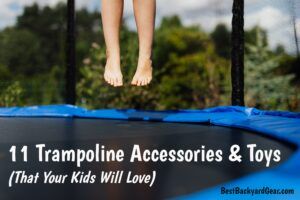
From basketball nets for awesome slam dunking to foam trampoline water-balloons, there are lots of fun ideas out there that will turn a trampoline into a source for endless fun, once basic bouncing has lost its appeal.
Check out these Trampoline Accessories Your Kids Will Love!
You’ll be surprised at how many cool options are available! But remember, the trampoline itself is also “enough”! Don’t feel you need to add accessories right away when you buy one. Save accessories for when the novelty of the trampoline itself has weakened somewhat.
Who invented the trampoline safety net?
Mark Publicover of the United Sates invented and patented the first commercially successful trampoline safety net enclosures. He began selling them in 1997, and within less than 10 years, more than 80% of backyard trampolines included them. Now-a-days you actually can not purchase a backyard trampoline without them!
The first trampolines with safety enclosures were sold by JumpSport Trampolines, who sell some of the most highly reviewed and excellent quality trampolines available on the market today.
See our review of JumpSport’s AlleyOOp DoubleBounce Backyard Trampoline to learn more about them!
How often should you replace the safety net?
At the beginning of every new season, the safety net should be carefully checked for rips, weaknesses, and holes. If you find any issues that are irreparable, act immediately. Contact the manufacturer of your trampoline and get a new net installed before your kids end up falling through the weak/damaged area and seriously injuring themselves. Murphy’s Law says that’s exactly where they will land.
Many trampolines come with a multiple year warranty on the frame, but at minimum a one year warranty (if not more) on the net as well. So check to see if you’re covered for a new one before spending money yourself.
Can you remove the safety net altogether?
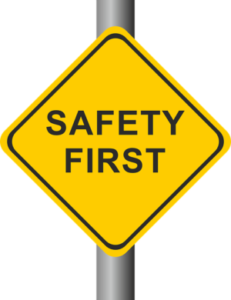
Please don’t!! While technically it is possible to do, and the trampolines of old all had no net, ask ANY emergency room doctor or nurse, and trampolines will be cited as one of the most common causes for injuries for kids. Removing the safety net altogether is a HUGE strike against the safety that you can provide your kids. Safety nets provide a MASSIVE amount of protection against injury. Even if you never see your kids bumping into the walls while they jump, they help guide jumpers to the center of the trampoline just by being there in the peripheral vision of the jumper.
What is a Springfree trampoline?
This video here explains nicely the difference between Springfree and spring-based trampolines.
Springfree trampolines use mat rods that lie beneath the trampoline instead of springs that surround the edges of the trampoline. The feel of the bounce is slightly different, yet many parents appreciate that toes and fingers are unable to get trapped in springs.
How long do backyard trampolines last?
You absolutely get what you pay for, when it comes to backyard trampolines. They are definitely not all created equal.
Two trampoline brands I recommend that provides excellent value and quality for a decent price tag would be the Zupapa Backyard Trampolines. and the ORCC Trampolines. They are well worth checking out.
Does Home Owners Insurance Cover Trampolines?
The short answer is “likely not”. Most home owners insurance policies do NOT cover trampolines because the liability risk is too high! If you have proper safety precautions and safety equipment, you MAY find the answer to be a “yes”, but it’s pretty uncommon. The best thing to do is to connect with your insurance agent and find out – BEFORE you have a slew of neighborhood kids jumping, twisting, and flipping in your backyard!
To read more about trampolines and insurance, check out this article by American Family Insurance that digs deep into the question.
In Summary
So, to sum it up, having a trampoline in your backyard can be a super fun addition to your outdoor space that everyone can enjoy. However, it’s important to make sure you’re taking the necessary precautions to stay safe and keeping up with maintenance. By following the tips and advice we’ve provided in this FAQ guide, you’ll have all the info you need to make an informed decision about whether a backyard trampoline is right for you and your family. So get ready to bounce into a whole lot of fun!
[Hopefully these answers to popular backyard trampoline FAQs have been helpful! Any other questions you’d like tackled, please send them in via the comments below.]

